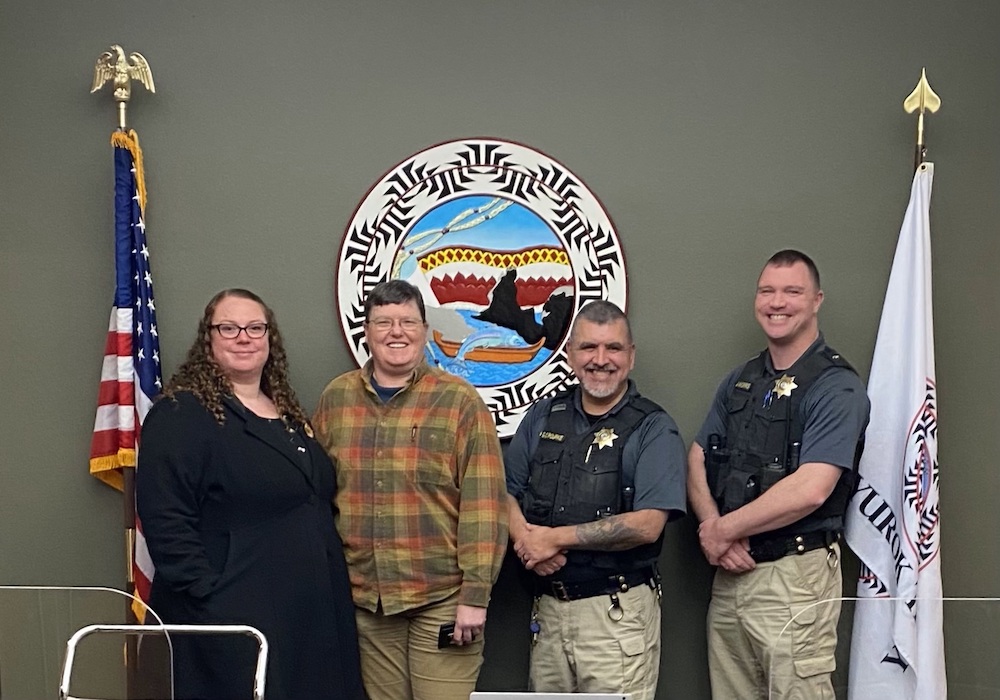
- Details
- By Elyse Wild
Hiring Oliveir is the latest in the Tribe’s efforts to combat the Missing and Murdered Indigenous Peoples Crisis.
In February, the Tribe was selected as the pilot partner for the U.S. Marshals Service (USMS) first-ever MMIP Initiative as part of the agency’s plans to develop tribally-led partnerships. The Yurok also hosted the 1st Annual Northern California Tribal Summit On MMIP in October 2022, bringing together 120 tribal leaders, survivors and lawmakers to identify solutions to the ongoing crisis.
According to a press release from the San Manuel Band of Mission Indians — which funded the Yurok MMIP Investigator position with a $350,000 grant — California is one of the top ten states with MMIP cases.
As Oliveira embarks on this landmark role, she faces hundreds of cold cases, eroded trust in law enforcement, and communities in desperate need of closure.
Oliveira talked to Native New Online about the growing awareness around the MMIP crisis, how Native communities can stay safe, and Yurok Tribe’s plans to bring targeted solutions to the MMIP crisis beyond California.
This interview has been edited for length and clarity.
We’ve seen more movement around MMIP in the past couple of years. Tell me what appealed to you about working with the Yurok Tribe on this issue.
Ironically enough, just before COVID, I was appointed to the Office of the Tribal Prosecutor’sMMIPFederal task force. It brought to my attention this under-acknowledged issue, and I wanted to make a difference besides just being a name on a list for a task force. So when this opportunity presented itself, it was just too much to pass up.
Do you guys really know how many open MMIP cases the YurokTribe currently has?
We have a loose number of approximately 200 MMIP cases in the state of California, and over half of those are in Northern California. I don’t have an exact number for the Yurok specifically, but I believe most of these cases — or a lot of these cases, at least — are overlapping cases because many folks belong to more than one Tribe.
Tell me about your history of working on missing persons cases. What are you bringing to the table to tackle this crisis?
During my tenure with the Humbolt County Sheriff’s Office, I took many initial cases for missing folks. Then, in 2006, for at least a year and a half, I was specifically assigned to missing persons cases. And the interesting is if you are reported missing, you are in the missing persons system — the National Missing and Unidentified Persons System — indefinitely.
So I will be able to go back decades to these cold cases in the system. Will I be able to solve all of them? Maybe not. Maybe I can get more information, and maybe I’ll be lucky. But, with my experience, at least I know that about the system.
I have a really good relationship with the sheriff’s office here in Humboldt, and I’m sure that I’ll be able to have a good relationship with the county, too. And I also have a pretty decent relationship with most of the tribes in the area. I feel like because of my experience in multiple facets, not just missing, but multiple investigative facets that I’ve had with the sheriff’s office and working with the Blue Lake Tribe as well. I’m bringing that all up here, and I’m excited about what we can get done.
Now, the wider population outside of Native communities has some awareness that this is a crisis. At the very least, the average news consumer is probably somewhat aware. So what do people need to know about why these cases differ from other missing persons cases?
I think what makes them different in a lot of ways is the neglect in these cases. But, again, because of the dismissiveness, I think historically — and I’m not blaming any law enforcement agency — but these cases have not been as thoroughly investigated as they could. And also, because of a lack of staffing and resources, it’s become a crisis. Hmm. But most certainly, if you go back some decades, there was a different mentality regarding missing and murdered indigenous peoples, which made those numbers higher than they should be.
Are there any unique barriers to solving these cases, even with dedicated law enforcement behind them?
For Indigenous people, it’s going to be trust. You know, historically, there’s a brutality issue that. But now I think it becomes that, again, that thing about the dismissiveness and lack of resources. Currently, I think it’s more a lack of resources still.
Because of the treatment of Indigenous people, there is still a huge amount of healing to be done. I am hoping from a tribal perspective that people will be more inclined to assist with these investigations. Then, hopefully, we can give some people closure.
So, what does the general public need to know about these cases, and how can people help?
Well, I want to go in and get closure to as many people as possible. So we will be initially creating response procedures and a model that hopefully can be used not just here but by any tribe in the United States because there are very few MMIP investigators in the country.
We need to establish a program to assist families all over the U.S., not just here. That is our long-term goal, which I suppose is a very grand goal, but I think it is doable with help from many facets, including volunteers. With all of that, the public needs to know that we are working in many facets, not just investigations but policy and law enforcement and mutual aid.
We are also trying to enhance what tribal law can do to hopefully take the burden off of other law enforcement agencies.
Are there any plans to help Indigenous communities stay safe since this is an ongoing crisis?
We will try to help establish self-defense programs and expand programs for mental health and drug rehabilitation.
The federal government has begun taking steps to address this crisis, but as someone who works in this arena, what else needs to be done nationally?
I think the government is finally getting to that place of “ok, now we need to do something.” I think supporting tribal governments and agencies in trying to deal with this because the government has a lot on its plate, too. But, again, I think if they put more trust in tribes to take care of their business and give them the funding and support that they need to do that, to identify these issues and the problems and help set up procedures where government agencies can also respond and assist when requested in a timely manner—those kinds of things need to happen. We don’t necessarily want the federal government stepping in and taking over the business. We want them to do is help us. It’s a situation that should have been dealt with a long time ago.
You have a lot of important work ahead — this is a brand-new position, and you are breaking new ground. What are you most looking forward to?
I’m humbled and honored to be able to be in this position. I truly want to make this model and share it so that all tribes can get some closure, do their own investigations, and build their intertribal trust to eliminate this crisis. That means everybody has to step up.
Tomorrow, Saturday, April 22, the Yurok Tribal Police Department is partnering with the California Department of Justice’s Office of Native American Affairs on Missing in California Indian Country, an event where families of MMIP can file a missing persons report with law enforcement, provide a family reference DNA sample, and enter their missing loved one into the National Missing and Unidentified Persons Database, among other services. Click here for more information.
More Stories Like This
Native News Weekly (August 25, 2024): D.C. BriefsUS Presidents in Their Own Words Concerning American Indians
Native News Weekly (January 18, 2026): D.C. Briefs
Federal Judge Orders ICE to Halt Use of Pepper Spray, Arrests of Peaceful Protesters in Twin Cities
Tunica-Biloxi Cultural Leader John D. Barbry Walks On
Help us defend tribal sovereignty.
At Native News Online, our mission is rooted in telling the stories that strengthen sovereignty and uplift Indigenous voices — not just at year’s end, but every single day.
Because of your generosity last year, we were able to keep our reporters on the ground in tribal communities, at national gatherings and in the halls of Congress — covering the issues that matter most to Indian Country: sovereignty, culture, education, health and economic opportunity.
That support sustained us through a tough year in 2025. Now, as we look to the year ahead, we need your help right now to ensure warrior journalism remains strong — reporting that defends tribal sovereignty, amplifies Native truth, and holds power accountable.
 The stakes couldn't be higher. Your support keeps Native voices heard, Native stories told and Native sovereignty defended.
The stakes couldn't be higher. Your support keeps Native voices heard, Native stories told and Native sovereignty defended.
Stand with Warrior Journalism today.
Levi Rickert (Potawatomi), Editor & Publisher


